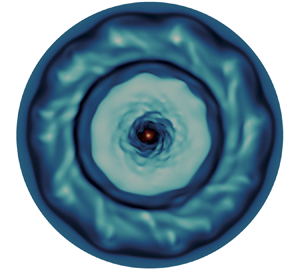Article contents
Efficient mixing by swirling electrovortex flows in liquid metal batteries
Published online by Cambridge University Press: 11 March 2021
Abstract

Using direct numerical simulations, we show that swirling electrovortex flows significantly enhance the mixing of the bottom layer alloy in liquid metal batteries during discharge. By studying the flow in various parameter regimes, we identify and explain a novel scaling law for the intensity of these swirling electrovortex flows. Using this scaling law and the model described in Herreman et al. (Phys. Rev. Fluids, vol. 5, 2020, 074501), we estimate the minimal intensity of the external magnetic field that is needed for the swirling electrovortex to enhance the mixing of the alloys in the bottom electrode of arbitrary liquid metal batteries.
- Type
- JFM Papers
- Information
- Copyright
- © The Author(s), 2021. Published by Cambridge University Press
References
REFERENCES
Herreman et al. supplementary movie 1
Swirling electrovortex flow intensity in axisymmetric simulation of Figure 4, from time t=0 s to 12s with intervals of 0.1 s.
Herreman et al. supplementary movie 2
Molar fraction in axisymmetric simulation of Figure 4, from time t=0 s to 12s with intervals of 0.1 s.
Herreman et al. supplementary movie 3
Evolution of the molar fraction with time in the three-dimensional simulation reported in Figure 5(b). Successive snapshots are not uniformly sampled in time: snapshots 1 to 6 (t = 1s to 6 s, every 1s), snapshots 7 to 23 (t = 6.5s to 14.5s, every 0.5s), snapshots 24 to 35 (t = 14.75s to 17.5s, every 0.25s), snapshots 36 to 42 (t=17.625s to 18.375s, every 0.125s).
Herreman et al. supplementary movie 4
Evolution of the molar fraction with time in the three-dimensional simulation reported in Figure 6(a). Successive snapshots are not uniformly sampled in time: snapshots 1 to 6 (t = 1s to 6 s, every 1s), snapshots 7 to 23 (t = 6.5s to 14.5s, every 0.5s), snapshots 24 to 35 (t = 14.75s to 17.5s, every 0.25s), snapshots 36 to 42 (t=17.625s to 18.375s, every 0.125s).
- 13
- Cited by





